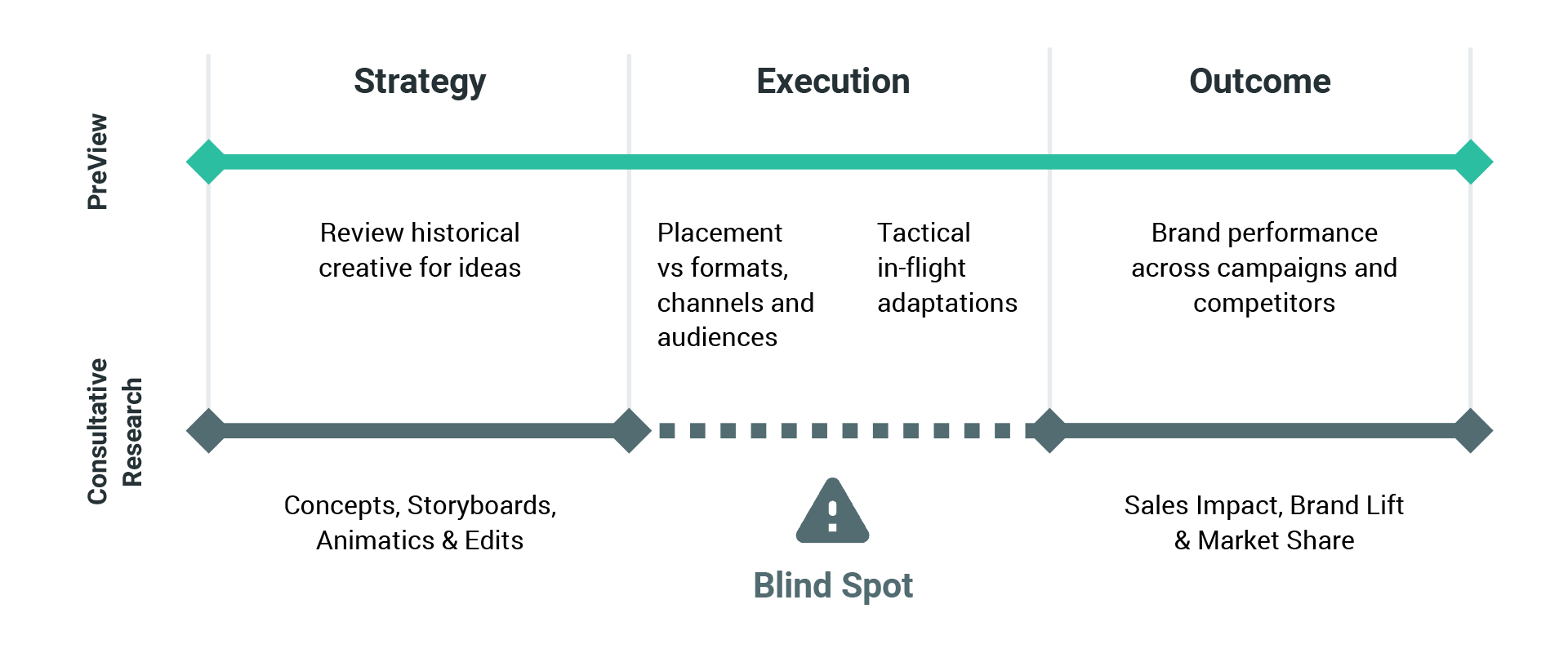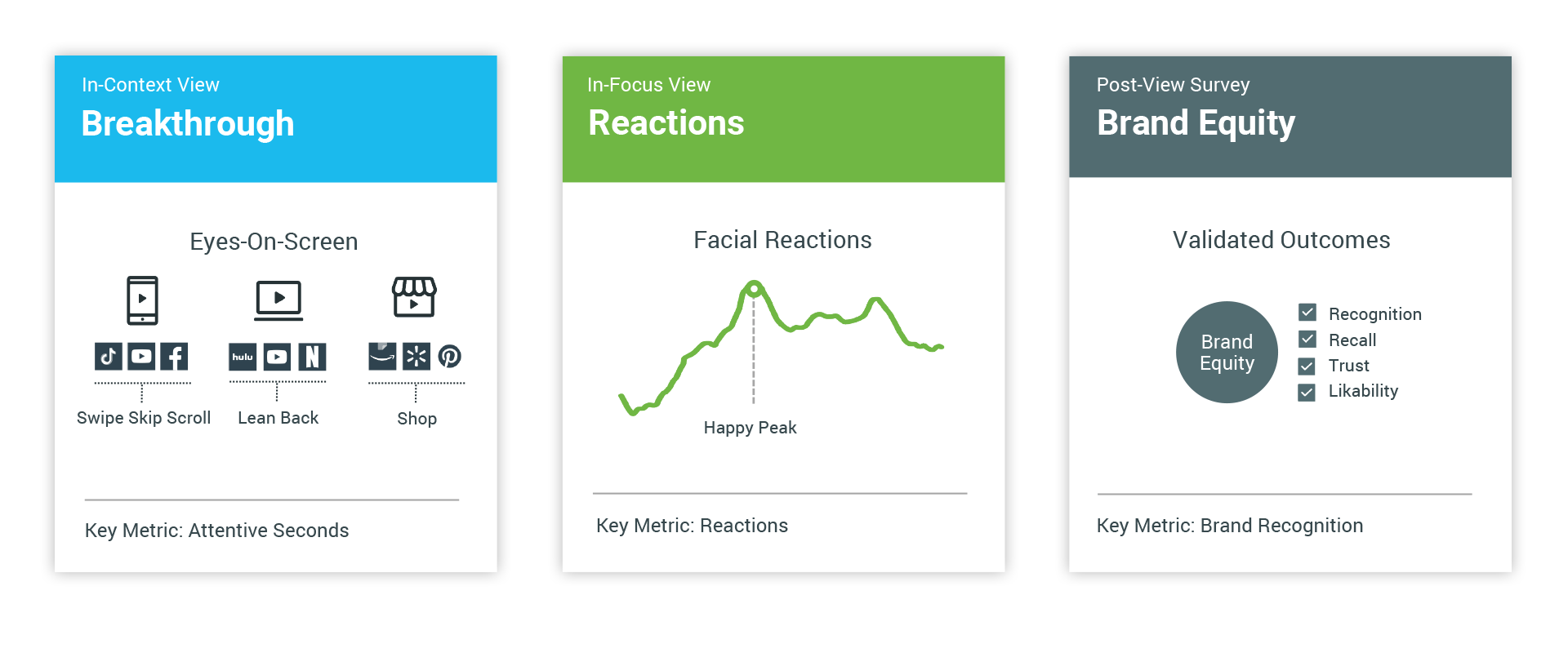
Using Visual Attention Metrics to Address The Digital Blind Spot in Advertising Effectiveness

Max Kalehoff
We have reached the point where even the most TV-centric brands now invest a majority of their advertising on digital channels like CTV or online video.
However, ad effectiveness measurement among brand advertisers largely remains glued to a linear TV model. The result is a potential loss of billions of dollars in performance gains, along with inferior consumer experiences.
Traditional Effectiveness Models Not Suited for a Digital World

The Analog Model of Advertising Effectiveness
The analog model of creative effectiveness measurement grew out of the linear TV and print era. There were a small number of hero creative assets, and a limited number of environments in which to place them. Analog effectiveness measures commonly fit into the Strategy phase of an advertising campaign. Advertisers apply focus groups and copy testing surveys to pre-production creative concepts, storyboards and animatics. In post-production, copy testing surveys sometimes prompt creative edits, or confirm readiness to launch hero creative on TV.
During or after the TV flight, advertisers often apply effectiveness studies to determine outcomes like brand lift, sales impact and market share. These techniques are costly and time-intensive, with recommendations typically delivered via research consulting and long PowerPoint presentations. Deliveries can take several weeks and cost tens of thousands of dollars for diagnosing just a handful of creative assets. Brand lift studies commonly focus on a single publisher or platform, so their relevance often is limited to that single platform.
| the cost and time of research consulting and copy diagnostics struggle when advertisers need to test, adapt and decision high volumes of creative variations for myriad digital media platforms like YouTube, Meta, and TikTok |
The Digital World Demands New Approaches to Advertising Effectiveness
Traditional research consulting remains highly relevant in the Strategy phase of campaigns as advertisers establish core insights, validate big creative ideas and test pre-production assets. However, the cost and time of research consulting and copy diagnostics struggle when advertisers need to test, adapt and decision high volumes of creative variations for myriad digital media platforms like YouTube, Meta, and TikTok, as well as the open Web. Moreover, the performance of any given creative asset is fluid depending on the media environment, so they must be factored in. Different markets and cultures also demand localized creative assets. All this adds up to inconsistent, or nonexistent, effectiveness measurements as campaigns move from the Strategy phase to Execution.
Sometimes best practices are applied to large digital creative portfolios, and impression-level interaction metrics (e.g., video-completion and clickthrough rates) are evaluated mid- or post-flight to understand creative and media placement effectiveness. Interaction metrics are ok for understanding lower-funnel outcomes, though they don’t always have a relationship with brand equity metrics or sales.
| Net: The big gap in advertising effectiveness measurement is in the 'Execution' phase |
Visual Attention Addresses the Digital Blind Spot of Ad Effectiveness
One solution to the digital blind spot lies in visual attention metrics.

Attention’s Strong Relationship with Effectiveness
According to a 2022 Realeyes survey of 320 senior advertising professionals, 90% report attention metrics are important, and 65% report that attention is a critical stage in the sales and customer journey. Over half of ad pros report their organization will invest in attention metrics this year.
More important, attention metrics have strong relationships with business outcomes, the Holy Grail of effectiveness. For example, Realeyes’ research with the Teads revealed that a 5% increase in visual attention can result in a 40% lift in brand awareness. We also learned, in a study with a major consumer electronics manufacturer, that high visual attention yields a 55% lift in shopping conversions. And our partner Mars Inc. used visual attention metrics to drive up to 18% incremental sales lift in 19 markets, along with $30 million in ad optimizations in 18 months.
Using Visual Attention Detection to Deliver Effectiveness Measurement
Computer vision and AI technology now enables fast, scalable intelligence into the probable in-market effectiveness of creative and digital media placements. For example, Realeyes’ PreView attention tool uses front-facing cameras to measure attention and emotional reactions of opt-in viewers as they view advertising within their personal mobile, laptop and desktop computing environments.
Realeyes’s PreView reports:
1) a creative’s ability to break through and command visual attention in live, cluttered media environments; 2) the viewers’ second-by-second emotional reactions to creative messaging; and 3) validation against four standardized brand survey metrics, including brand recognition, ad recall, likability and trust.

Visual Attention Tech Yields Better Data Quality
Tapping into ubiquitous front-facing cameras on every participant’s media device, Realeyes has condensed the testing experience into two or three minutes, on average. This results in a more observational and natural experience – which improves human data quality while decreasing the risk of tarnishing brands with excessive, fatiguing survey tasks.
| AI can improve panel quality by eliminating duplicate and fraudulent participants. The tech can even infer more accurate audience demographic data, overcoming intentional and accidental errors inherent with self-reporting. |
Additionally, computer vision and AI can improve panel quality by eliminating duplicate and fraudulent participants. The tech can even infer more accurate audience demographic data, overcoming intentional and accidental errors inherent with self-reporting. For example, Realeyes has found that easily 25% of panelists sourced from best-in-class providers can be fraudulent or duplicate. Realeyes also has found, in some cases, that up to 50% of non-white panel participants may misidentify their race. Removing deterrents to data quality improves confidence while reducing sample costs.

Attention Technology Disrupts Economics of Effectiveness Measurement
PreView attention measurement tool disrupts research pricing conventions, which have prohibited the testing of large creative portfolios, in context, across channels and markets. For example, PreView commonly commands a 7X price-to-value difference versus traditional research. Traditional research and consulting remain relevant, especially when deeper diagnostics and data storytelling are needed on a smaller number of hero creative assets. However, the new economics of attention tools unlock the possibility to measure every ad’s potential performance and contextual placement – the halo.
Advertisers Must Heighten Digital Analytics Capabilities
Arovedvertising attention intelligence is different than consultative research. Modern advertising systems require faster, fluid decisioning and optimization. That is not possible with large once-in-a-while survey projects with consultative diagnosis on PowerPoints. The paradigm of always-on intelligence for advertising’s Execution phase requires competence with key metrics that link to outcomes – which can be imported in real-time decisioning and visualization tools. These capabilities are more prevalent in modern performance marketing organizations, like many DTC brands, less so in large incumbent brand companies. The teams who embrace modern data and analytics stand to gain competitive advantage.
Solve the Ad Effectiveness Blind Spot, Join the Attention Revolution
The Mars Inc. case study above is a best-in-class model of using attention to address the digital blind spot of advertising effectiveness. It won the 2022 I-COM Data Creativity Awards and ANA Echo Data Awards and is a winning paper for the Advertising Research Foundation’s 2023 Audience x Science conference. Most important, attention metrics drive advertising effectiveness at scale, culminating in better business outcomes globally.
Let's discuss
If so, please leave your details.